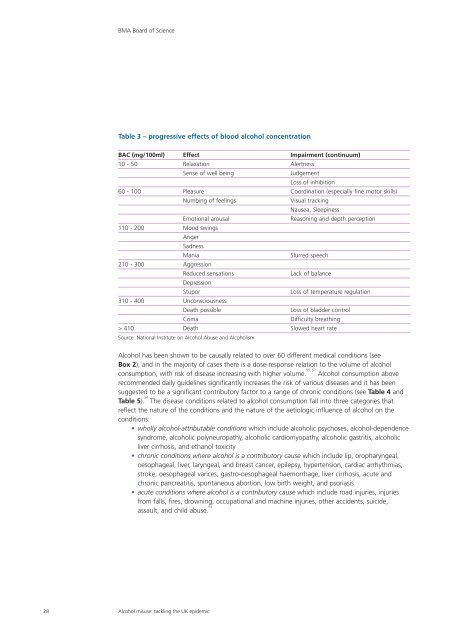Alcohol misuse: tackling the UK epidemic - London
Alcohol misuse: tackling the UK epidemic - London
Alcohol misuse: tackling the UK epidemic - London
You also want an ePaper? Increase the reach of your titles
YUMPU automatically turns print PDFs into web optimized ePapers that Google loves.
28<br />
BMA Board of Science<br />
Table 3 – progressive effects of blood alcohol concentration<br />
BAC (mg/100ml) Effect Impairment (continuum)<br />
10 - 50 Relaxation Alertness<br />
Sense of well being Judgement<br />
Loss of inhibition<br />
60 - 100 Pleasure Coordination (especially fine motor skills)<br />
110 - 200 Mood swings<br />
Numbing of feelings Visual tracking<br />
Nausea, Sleepiness<br />
Emotional arousal Reasoning and depth perception<br />
Anger<br />
Sadness<br />
210 - 300 Aggression<br />
Mania Slurred speech<br />
Reduced sensations Lack of balance<br />
Depression<br />
310 - 400 Unconsciousness<br />
Stupor Loss of temperature regulation<br />
Death possible Loss of bladder control<br />
Coma Difficulty breathing<br />
> 410 Death Slowed heart rate<br />
Source: National Institute on <strong>Alcohol</strong> Abuse and <strong>Alcohol</strong>ism<br />
<strong>Alcohol</strong> has been shown to be causally related to over 60 different medical conditions (see<br />
Box 2), and in <strong>the</strong> majority of cases <strong>the</strong>re is a dose-response relation to <strong>the</strong> volume of alcohol<br />
55, 57<br />
consumption, with risk of disease increasing with higher volume. <strong>Alcohol</strong> consumption above<br />
recommended daily guidelines significantly increases <strong>the</strong> risk of various diseases and it has been<br />
suggested to be a significant contributory factor to a range of chronic conditions (see Table 4 and<br />
Table 5). 54<br />
The disease conditions related to alcohol consumption fall into three categories that<br />
reflect <strong>the</strong> nature of <strong>the</strong> conditions and <strong>the</strong> nature of <strong>the</strong> aetiologic influence of alcohol on <strong>the</strong><br />
conditions:<br />
wholly alcohol-attributable conditions which include alcoholic psychoses, alcohol-dependence<br />
syndrome, alcoholic polyneuropathy, alcoholic cardiomyopathy, alcoholic gastritis, alcoholic<br />
liver cirrhosis, and ethanol toxicity<br />
chronic conditions where alcohol is a contributory cause which include lip, oropharyngeal,<br />
oesophageal, liver, laryngeal, and breast cancer, epilepsy, hypertension, cardiac arrhythmias,<br />
stroke, oesophageal varices, gastro-oesophageal haemorrhage, liver cirrhosis, acute and<br />
chronic pancreatitis, spontaneous abortion, low birth weight, and psoriasis<br />
acute conditions where alcohol is a contributory cause which include road injuries, injuries<br />
from falls, fires, drowning, occupational and machine injuries, o<strong>the</strong>r accidents, suicide,<br />
assault, and child abuse. 55<br />
<strong>Alcohol</strong> <strong>misuse</strong>: <strong>tackling</strong> <strong>the</strong> <strong>UK</strong> <strong>epidemic</strong>
















